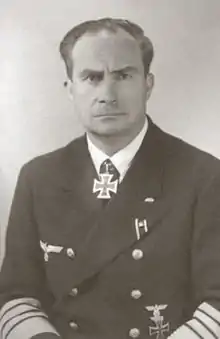Kurt Fricke
Kurt Fricke (8 November 1889 – 2 May 1945) was an Admiral with the Kriegsmarine (navy) of Nazi Germany during World War II and a recipient of the Knight's Cross of the Iron Cross.
Kurt Fricke | |
|---|---|
 | |
| Born | 8 November 1889 Berlin |
| Died | 2 May 1945 (aged 55) Berlin |
| Allegiance | |
| Service/ | |
| Years of service | 1910–45 |
| Rank | Admiral |
| Unit | SMS Hertha SMS Moltke |
| Battles/wars | World War I
World War II |
| Awards | Knight's Cross of the Iron Cross |
Biography
Fricke entered the Kaiserliche Marine as a cadet on 1 April 1910. He served on SMS Hertha during his cadetship and graduated from Marineschule Mürwik. After graduating he was posted to the battlecruiser SMS Moltke. On 27 September 1913 Fricke was promoted to lieutenant. During World War I, Fricke served at the Battle of Dogger Bank. Fricke was promoted to Oberleutnant zur See in 1916 and transferred to torpedo boats. He served on G103 and G101. On 7 March 1918 he became an aide-de-camp to the commander of the torpedo boats, in which position he ended the war.
After the war he served in the administration of the German navy as adjudant to the commander in chief of the navy. From 1922 to 1924 he served on the I Flottille, in which he commanded destroyers T139 and T148. In September 1924, Fricke became a company officer in a coastal defence unit. Fricke was promoted to corvette captain in 1928. He served three years as a marine adjudant to the Reichswehrminister.
In 1929 Fricke was made commander of half a squadron of torpedo boats. On 16 September 1931 he became commander of the I. Torpedobootsflottille. In 1933 he became Führer der Torpedoboote (type commander of torpedo boats). On 1 April 1934 Fricke was promoted to Fregattenkapitän (frigate captain). Fricke then was posted as chief of staff to the inspectorate of destroyer and mine-warfare in the rank of Kapitän zur See (captain at sea) (1935). From October 1936 to September 1937 he served at the Wehrmacht-Akademie. After this academic posting, Fricke served on the Oberkommando der Marine as Chief of the Operations department of the Seekriegsleitung. On 30 April 1939 Fricke became liaison officer to the Oberbefehlshaber der Luftwaffe.
After the start of the Second World War, Fricke was promoted to Konteradmiral (rear admiral) on 1 November 1939 and Vizeadmiral (vice admiral) on 1 June 1941. From 13 June 1941 to 20 February 1943 Fricke was Chief of Staff of the Seekriegsleitung. Promoted to Admiral on 1 April 1942, Fricke was named commander of the Marinegruppenkommandos Süd (21 March 1943 – 11 December 1944). In December 1944 Fricke was placed in the Führerreserve. Fricke was killed on 2 May 1945 during the Battle of Berlin.
Awards
- Iron Cross (1914)
- Friedrich August Cross (Oldenburg)
- Hanseatic Cross, Hamburg (14 June 1916)[2]
- Knight's Cross of the House Order of Hohenzollern with Swords (5 March 1918)[2]
- Knight's Cross, First Class of the Order of the Sword (Sweden, 12 July 1930)[2]
- The Honour Cross of the World War 1914/1918 1914/1918 (1934)[2]
- Sudetenland Medal (22 May 1939)
- Wehrmacht Long Service Award, 1st with 4th Class (2 October 1936)[2]
- Order of Naval Merit, 3rd class in White (Spain, 21 August 1939)
- Clasp to the Iron Cross (1939)
- Memel Medal (26 October 1939)
- Order of the Yugoslav Crown, 2nd class with Star (9 November 1939)
- Order of Military Merit (Bulgaria), 1st class with War Decoration (Bulgaria, 1942)
- Order of the Cross of Liberty, 1st class with Oak Leaves and Swords (Finland, March 25, 1942)
- Order of Michael the Brave, 3rd class (1 September 1942)
- Grand Cross of the Order of the Crown of King Zvonimir with swords (Croatia, 26 September 1942)
- Knight's Cross of the Iron Cross on 1 October 1942 as Admiral and chief-of-staff in Naval Operations (Seekriegsleitung) in the Naval High Command (Oberkommando der Marine)[3][4]
- Grand Cross of the Order of the Star of Romania with swords and military band of virtue (7 October 1942)
References
Citations
- Dörr 1995, p. 189.
- Dörr 1995, p. 190.
- Scherzer 2007, p. 319.
- Fellgiebel 2000, p. 187.
Bibliography
- Dörr, Manfred (1995). Die Ritterkreuzträger der Überwasserstreitkräfte der Kriegsmarine—Band 1: A–K [The Knight's Cross Bearers of the Surface Forces of the Navy—Volume 1: A–K] (in German). Osnabrück, Germany: Biblio Verlag. ISBN 978-3-7648-2453-2.
- Fellgiebel, Walther-Peer (2000) [1986]. Die Träger des Ritterkreuzes des Eisernen Kreuzes 1939–1945 — Die Inhaber der höchsten Auszeichnung des Zweiten Weltkrieges aller Wehrmachtteile [The Bearers of the Knight's Cross of the Iron Cross 1939–1945 — The Owners of the Highest Award of the Second World War of all Wehrmacht Branches] (in German). Friedberg, Germany: Podzun-Pallas. ISBN 978-3-7909-0284-6.
- Range, Clemens (1974). Die Ritterkreuzträger der Kriegsmarine [The Knight's Cross Bearers of the Navy]. Stuttgart, Germany: Motorbuch Verlag. ISBN 978-3-87943-355-1.
- Scherzer, Veit (2007). Die Ritterkreuzträger 1939–1945 Die Inhaber des Ritterkreuzes des Eisernen Kreuzes 1939 von Heer, Luftwaffe, Kriegsmarine, Waffen-SS, Volkssturm sowie mit Deutschland verbündeter Streitkräfte nach den Unterlagen des Bundesarchives [The Knight's Cross Bearers 1939–1945 The Holders of the Knight's Cross of the Iron Cross 1939 by Army, Air Force, Navy, Waffen-SS, Volkssturm and Allied Forces with Germany According to the Documents of the Federal Archives] (in German). Jena, Germany: Scherzers Militaer-Verlag. ISBN 978-3-938845-17-2.
| Military offices | ||
|---|---|---|
| Preceded by Admiral Otto Schniewind |
Chief of Staff of the Seekriegsleitung 13 June 1941 – 20 February 1943 |
Succeeded by Admiral Wilhelm Meisel |